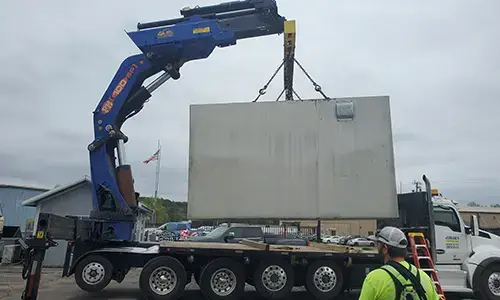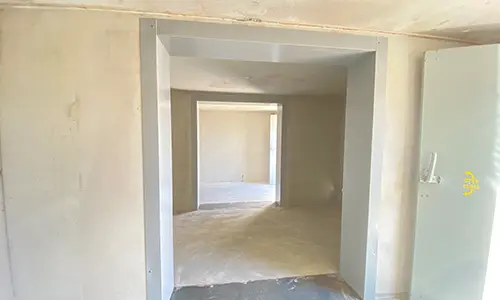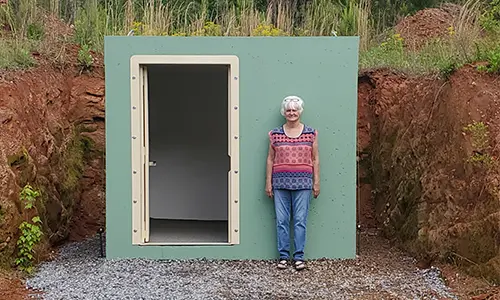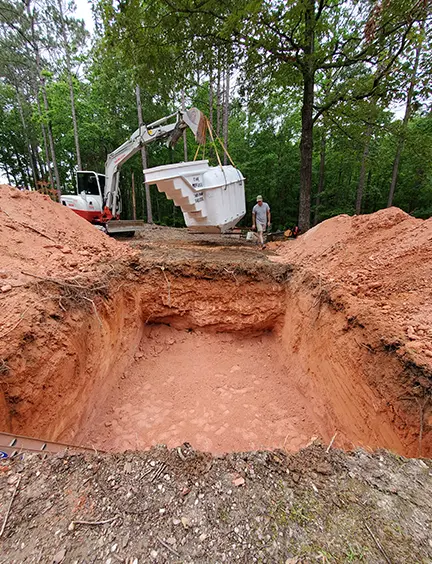Safe Rooms in Alabama: How Tornado Shelters Work


Why Every Alabama Home Needs a Safe Room
When a tornado warning sounds in Alabama, hesitation can cost lives. Tornadoes in this state often form quickly, move fast, and strike with little notice, especially across Dixie Alley and North Alabama. In those moments, your family does not need a plan that might work. You need a structure that is specifically engineered to protect human life. That is where an Alabama safe room becomes essential.
A safe room is not simply a reinforced closet or a strong interior wall. It is a purpose built structure designed to withstand extreme wind speeds, airborne debris, and the structural collapse of the surrounding building. For homeowners across Alabama, storm shelters are no longer optional upgrades. They are a critical part of responsible home safety planning.
Whether you live in Birmingham, North Alabama, or a rural area where emergency response times may be longer, having a safe room provides certainty when storms become dangerous. This guide explains how safe rooms work, why they are so effective, and how Alabama homeowners can choose the right solution for long term safety and peace of mind.
What Is an Alabama Safe Room
An Alabama safe room is a reinforced space designed to protect occupants during tornadoes and other severe weather events. These rooms are built using steel, concrete, or a combination of impact resistant materials and are anchored directly to a foundation or slab.
Unlike standard rooms in a home, a safe room is engineered to resist the most destructive forces a tornado can produce. This includes wind speeds exceeding 250 miles per hour and high velocity debris impacts that can penetrate typical building materials.
Safe rooms can be installed in several locations, including inside the home, in a garage, or as a standalone structure nearby. Many homeowners choose professionally engineered safe rooms that meet nationally recognized safety standards and are designed specifically for Alabama storm conditions.
The primary purpose of a safe room is simple. It is designed to remain intact even if the rest of the structure around it is damaged or destroyed.
Why Safe Rooms Matter in Alabama
Alabama consistently ranks among the most tornado prone states in the country. Unlike the open plains of the Midwest, Alabama’s terrain includes trees, hills, and dense residential development. These features can limit visibility and reduce warning times, making storms even more dangerous.
Storm shelters in Alabama provide a level of protection that standard homes cannot. Even well built houses are vulnerable to roof loss, wall collapse, and structural failure during strong tornadoes. A safe room provides a reinforced space that is designed to withstand those forces.
For families searching for storm shelters Alabama residents trust, safe rooms offer a reliable solution that works in both urban and rural settings. They are especially important for homes without basements, which are common throughout much of the state.
How Safe Rooms Protect Against Tornadoes
The effectiveness of a safe room lies in its engineering. Every component is designed to work together to protect occupants from the primary dangers associated with tornadoes.
Structural Strength
Safe room walls are constructed from reinforced concrete or heavy gauge steel. These materials are chosen for their ability to resist impact and maintain structural integrity under extreme pressure.
Debris Impact Resistance
One of the most dangerous aspects of a tornado is flying debris. Safe rooms are tested to resist impacts from large objects traveling at high speeds. This prevents penetration that could otherwise cause serious injury or death.
Anchoring Systems
Proper anchoring is critical. A safe room is bolted directly into a concrete slab or foundation using heavy duty anchor systems. This prevents uplift and movement during high wind events.
Ventilation and Airflow
Ventilation systems are designed to maintain airflow even if debris blocks exterior openings. This ensures occupants can breathe safely during extended sheltering periods.
Secure Doors and Hardware
Safe room doors are reinforced and designed to remain operational even after debris impact. Hinges, latches, and frames are tested to withstand extreme pressure.
Together, these elements create a protective envelope that allows the safe room to function even when the surrounding structure fails.
Safe Room Installation in Alabama Homes
Installing a safe room requires careful planning and professional expertise. Alabama homeowners typically install safe rooms in one of several locations depending on property layout and personal needs.
Interior Safe Rooms
Interior safe rooms are often built within the footprint of the home. These rooms offer quick access and are ideal for families who want immediate protection without going outside during storms.
Garage Installed Safe Rooms
Garage installations are popular because they provide easy access and allow for reinforced anchoring to a concrete slab. Many homeowners combine garage installations with above ground storm shelters for added convenience.
Standalone Safe Rooms
Standalone units are installed outside the home but nearby. These may be appropriate for properties with limited interior space.
Installation typically includes site evaluation, anchoring preparation, wall and ceiling assembly, door installation, and final inspection. Professional installation ensures the safe room meets safety standards and performs as intended.
Above Ground and Underground Safe Room Options
Alabama homeowners often compare above ground and underground storm shelter options when planning their installation.
Above Ground Safe Rooms
Above ground safe rooms are installed at surface level and anchored into concrete slabs. These shelters are easier to access for children, elderly individuals, and people with mobility challenges.
Modern designs such as the unpainted concrete above ground storm shelter offer exceptional durability with minimal maintenance. Above ground shelters eliminate concerns related to flooding and groundwater.
Underground Safe Rooms
Underground shelters provide natural protection from wind and debris due to their below ground placement. These shelters require careful drainage planning and waterproofing.
Homeowners interested in this option often explore professionally engineered underground storm shelters designed specifically for Alabama soil and weather conditions.
Both options provide excellent protection when properly installed. The safest tornado shelter is the one that is accessible, certified, and suited to your property.
Safe Rooms and Storm Shelters Across Alabama
Demand for storm shelters in Alabama continues to grow as homeowners become more aware of storm risks.
In North Alabama, residents frequently search for north Alabama storm shelters due to the region’s history of severe tornado outbreaks. Urban areas like Birmingham see high demand for interior safe rooms and garage installations that fit within smaller lot sizes.
Families researching storm shelters Birmingham AL often prioritize quick access and certified construction. Across the state, homeowners looking for storm shelters for sale in Alabama benefit from a wide range of residential and community options.
Community based solutions also play a critical role in storm preparedness. Community storm shelters provide shared protection for neighborhoods, schools, and workplaces where private shelters may not be feasible.
Common Mistakes to Avoid When Installing a Safe Room
Installing a safe room is a major safety investment, and mistakes can reduce its effectiveness.
One common mistake is choosing a shelter that does not meet recognized safety standards. Not all storm shelters offer the same level of protection, so certification and professional installation are essential.
Improper anchoring is another serious issue. A shelter that is not securely attached to a foundation may fail during extreme winds.
Accessibility is also often overlooked. A safe room must be easy to reach quickly. Narrow doorways, cluttered access paths, or poorly planned locations can delay entry during emergencies.
Finally, failing to maintain the shelter can create problems. Regular inspections of doors, bolts, and ventilation systems ensure long term reliability.
What to Store Inside an Alabama Safe Room
A safe room should be stocked with essential supplies to support occupants during and after a storm.
Recommended items include drinking water, non perishable food, flashlights, extra batteries, first aid supplies, blankets, and necessary medications. Communication devices such as charged mobile phones or weather radios help occupants stay informed.
Organizing supplies and checking them regularly ensures everything is ready when needed. A prepared shelter reduces stress and improves safety outcomes.
How Safe Rooms Save Lives in Alabama
Safe rooms are not theoretical safety measures. They have repeatedly proven their value during real tornado events across the state.
Families sheltering in safe rooms have survived direct hits from powerful tornadoes while surrounding structures were severely damaged. In mobile home communities, shared shelters have protected dozens of residents who otherwise had no safe place to go.
Schools, businesses, and public facilities across Alabama are increasingly installing safe rooms to protect large groups during severe weather. These real world applications demonstrate why safe rooms are considered one of the most reliable forms of tornado protection.
The Future of Safe Rooms and Storm Shelters in Alabama
Advances in materials and engineering continue to improve safe room design. New construction methods increase impact resistance, improve ventilation, and enhance comfort during extended sheltering.
Community awareness is also growing. As more homeowners invest in storm shelters Alabama wide, safe rooms are becoming a standard feature rather than a luxury upgrade.
Local builders and manufacturers are adapting designs to meet the specific needs of Alabama homes, ensuring shelters are practical, durable, and accessible.
Final Thoughts on Alabama Safe Rooms
An Alabama safe room is one of the most effective ways to protect your family from tornadoes and severe storms. It is a structure built with one purpose in mind, preserving life when conditions become dangerous.
Whether you are researching storm shelters in Alabama, considering above ground storm shelter Alabama options, or looking for storm shelters for sale in Alabama, the most important step is taking action before storms arrive.
A properly designed and installed safe room provides more than physical protection. It offers peace of mind, confidence, and the ability to face Alabama’s unpredictable weather knowing your family has a secure place to go.
Preparation today is what keeps families safe tomorrow.




